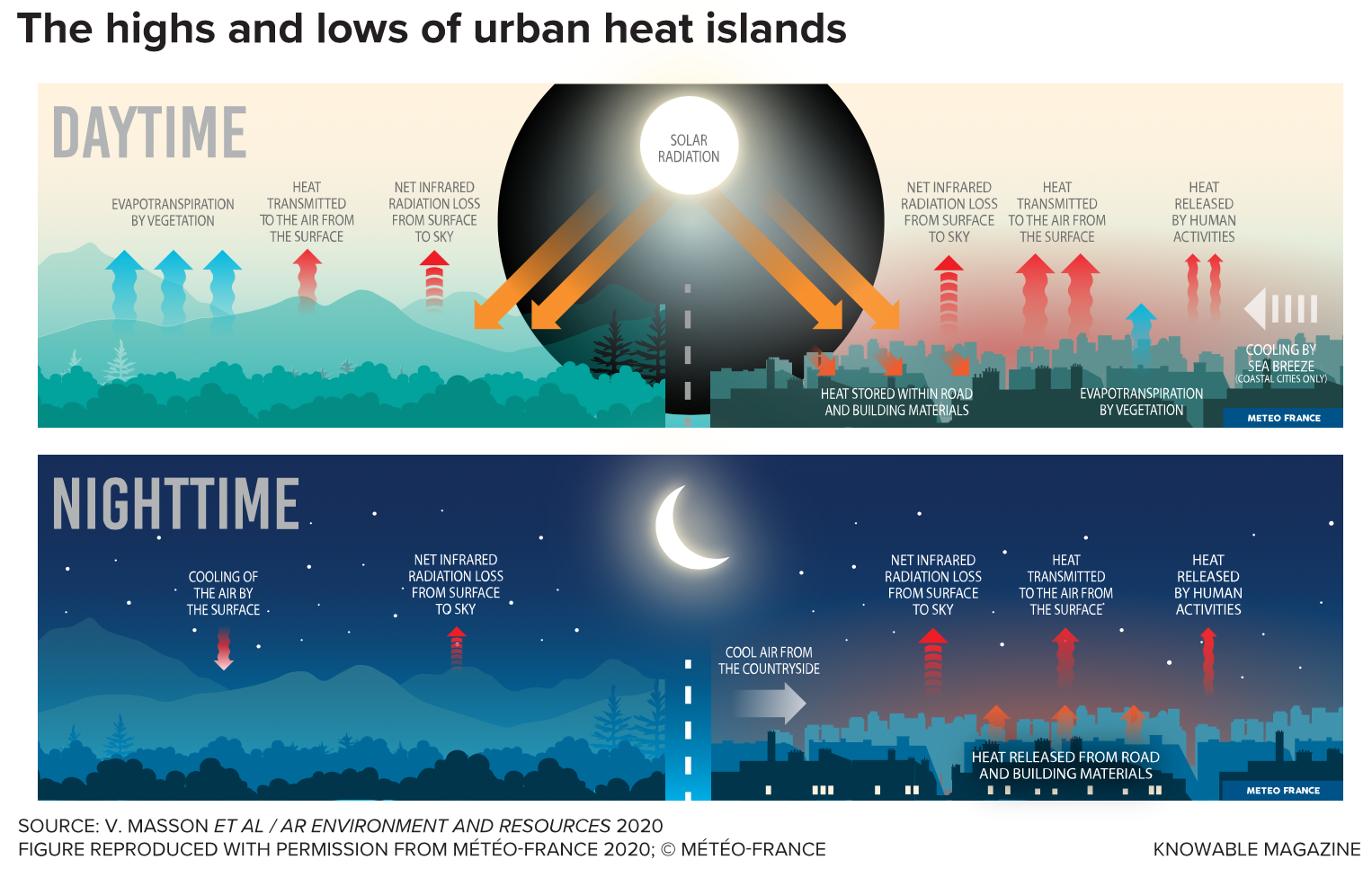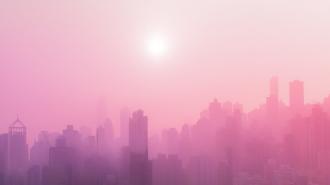Sidewalks without a hint of shade. Heat radiating up from asphalt streets and down from walls. Hot exhaust belching from cars, trucks and buses — all these summer-in-the-city miseries and more are contributors to the urban heat-island effect.
Depending on the city, says Angel Hsu, an environmental scientist who founded and heads the Data-Driven EnviroLab at the University of North Carolina at Chapel Hill, its downtown area can average 3 to 4 degrees Celsius hotter than the surrounding suburbs and countryside. And certain neighborhoods — often the poorest — can be hotter by 10 degrees Celsius or more.
Worse, says Hsu, this is not just a matter of discomfort. The heat-island effect is starting to endanger the health, productivity and lives of billions of people worldwide, especially now that it’s coming on top of killer heat waves spawned by climate change. And in a classic vicious circle, she adds, the straightforward solution — use more air conditioning — is hugely energy-intensive and could push climate-warming greenhouse gas emissions even higher than they already are.
The good news, says Hsu, is that excess urban heat isn’t inevitable. Knowable Magazine recently spoke with her about ways to mitigate the effect — one of several topics covered in a report that she coauthored in the 2021 Annual Review of Environment and Resources on how cities can reach their goal of reducing greenhouse gas emissions to zero.
This conversation has been edited for length and clarity.
What causes the urban heat-island effect?
Primarily, it’s the conversion of natural landscapes to urban infrastructure: materials like asphalt, brick and concrete that tend to absorb more solar radiation than a grassy or a forested area. But in addition, this conversion makes urban areas and cities a lot less able to absorb rainwater. As a result, you get more runoff and less of the nice cooling effect from evapotranspiration, which is when grasses and trees move water from the ground into the air.
Then there’s the way people live in cities. They drive cars. They have air conditioners, which cool interior spaces by sucking out the heat and dumping it into the air outside. They build apartments and houses and offices that are incredibly dense, providing little room for green space and air circulation. All of this increases the heat.
And of course, this has all been happening as climate change has shifted the baseline background temperature an average of 1.1 degrees Celsius above pre-industrial levels, which makes our urban heat islands feel that much hotter.
How does the effect vary from one neighborhood to the next?
It depends on a lot of things, including how built-up an area is, and how much tree cover and green space it has. But there are still many gaps in our understanding. For example, many cities measure temperature from just one monitoring station, which is often located at the airport. But most people live in downtown areas or in suburbs far away from the airport. So whether you’re a decision-maker or an individual, there are going to be questions you can’t answer with that one number. I have young kids, for example — is it safe to take them outside to play?
This is why a lot of my work has been focused on getting better granular data. In a study last summer, for example, we partnered with the town of Chapel Hill and the Museum of Life and Science in Durham, North Carolina, to send citizen scientists out with handheld temperature and humidity sensors on an incredibly hot day in late August. The official weather station for Chapel Hill said that temperatures were something like 93 degrees Fahrenheit (34 degrees Celsius). But in some parts of downtown, our volunteers were measuring temperatures as high as 108 degrees Fahrenheit (42 degrees Celsius). This is consistent with other studies, including ours, showing that heat disparities exist within cities throughout the US.
One reason for that huge difference is that, when you’re walking in a downtown area that’s been baking in the sun on a hot summer day, you don’t just feel the air temperature. You’re also feeling all the absorbed heat radiating back at you from the sidewalk, and the asphalt, and the buildings as well. In the scientific literature, this total heat load is called the mean radiant temperature. And unfortunately, weather stations and satellites can’t get this number at an individual scale.
How does urban heat affect the people who live in cities?
A lot of studies in the public health literature have shown that underlying health conditions like diabetes and cardiovascular disease are actually made worse when people are exposed to heat, particularly in older demographics.
And then there are these extreme heat events. The 2003 European heat wave comes to mind, when there were tens of thousands of people who died from temperatures that spiked during that summer. We’ve started to see that again this past summer in Europe, the Pacific Northwest in the US, China and India, each of which had weeks of blistering, 100-plus degree Fahrenheit temperatures. That led to all those premature deaths, along with other less deadly but more prevalent health effects such as dehydration and heatstroke.
Finally, there are a lot of subtle, but pernicious effects. Some studies show that aggression levels and crime rates tend to go up when temperatures are higher. Other studies have looked at schools during particularly intense heat events — especially schools that lack air conditioning, or properly working air conditioning — and find that test scores tend to be lower because students are less able to concentrate and study.
Even more pernicious is that heat within cities doesn’t affect everyone in the same way.

Do you mean that the effects are worse in disadvantaged areas?
Yes. We did a research study where we looked at neighborhoods in all the major urban areas in the continental US with a population of more than a quarter million, about 175 cities, and found that people living below the poverty line and people of color were systematically exposed to higher levels of urban heat than wealthier counterparts, who are often white. It’s important to note that most people of color are not living in poverty. But we still found that a person of color had roughly the same exposure to the urban heat island effect as a person living in poverty. The only six cities where we didn’t see this disproportionate exposure were those that didn’t have high percentages of people of color. That was really shocking to me.
We’re seeing some of the same patterns when we look at cities across the world: People who live in neighborhoods that have less income per person tend to be exposed to higher levels of urban heat than those who are wealthier.
Why does income make such a difference?
There are many reasons. In higher-income neighborhoods, for example, there is often more tree cover and green space, which provides shade and more evaporative cooling than buildings, streets and sidewalks. Also, population density is usually higher in lower-income areas, where structures and housing are often packed tightly together, inhibiting air circulation, and have less green space and tree cover.
What’s the solution? More air conditioning?
The increasing demand for air conditioning in cities is just an inevitability because of how humans have affected the climate. Look at what happened in Europe this past summer, when people were dying in the heat wave because they didn’t have access to air conditioning — because they traditionally have not needed it.
But air conditioning uses a lot of electricity, and when electricity to power that cooling is sourced from more fossil fuels, climate change can be made even worse.
Ultimately, of course, we hope to power air conditioning and everything else with renewable sources of electricity such as wind and solar. We also need to encourage the use of energy-efficient technologies like heat pumps, which are essentially air conditioners modified to work in both directions. The modern ones can be somewhat more efficient than old-line central air systems at pumping heat out of your building in the summer, and much more efficient than a standard furnace or electric heater at pumping heat in to warm the place in the winter.
Then we need to replace the hydrofluorocarbon refrigerants that most air conditioners and heat pumps use. The most common ones have around 1,000 to 3,000 times the potency of carbon dioxide as a greenhouse gas.
And in the meantime, we need to do anything we can to make cities cooler.
How do we manage that?
There are some things that individuals can do. Personal transport is a big one. The internal combustion engine generates a lot of heat, whether it’s cars in developed countries or the motor scooters that a lot of people ride in the Global South and developing countries. So taking public transit, or using electric vehicles, electric bikes or bicycles can help.
Or, if you have the opportunity to build your own house, you could use materials that are not as heat-absorbing. I’m thinking about the house in Greer, South Carolina, where I grew up: It was brick, and just incredibly hot to live in in the summer. There are lots of alternatives that would be cooler and lower your energy bills, including natural building materials like wood or bamboo. Another recent example was in our current house, where we ended up choosing to cover an addition to our roof with a type of TPO (thermoplastic polyolefin) that reflected heat better than the standard roofing material.
But there are limits to individual action. If you live in an apartment building, you can’t just decide to go up and plant a green roof or paint your rooftop white to make it more reflective, because somebody else owns that building. The same goes for planting trees, which can cool your neighborhood by providing shade and transpiration: Most public parks and street corridors are owned and controlled by the city.
So overall, tackling urban heat needs to be a government-led effort, simply because governments have the jurisdiction and can impose mandates on a much larger scale. I think about one example in New York City about 13 years ago. Michael Bloomberg, who was mayor at the time, said that a certain square footage of New York City’s rooftops was going to be made into cool roofs. So I volunteered and spent an afternoon painting a rooftop white, which increased its surface reflectance.
I also think about a high-resolution mapping campaign where our lab volunteered with Raleigh and Durham, North Carolina, to send out citizen scientists to identify areas that were particularly vulnerable and particularly hot using mobile car sensors. Based on that, Raleigh decided to invest in urban-heat mitigation measures, including coating some of the roadways with titanium oxide to make them more reflective.
And I think about Singapore, where I lived for five years. Urban heat is a huge issue for Singapore, since it’s located at the equator and has extremely high levels of humidity. So some of its shopping malls are designed like wind tunnels to allow for breezes to pass through and carry heat away instead of trapping it between the buildings. Singapore has also been doing a lot of research on building materials, and how to make them less absorptive and produce less radiant heat. And they’ve done a lot of thinking about vertical gardens and rooftop gardens to cool buildings.
What’s the long-term outlook? Can we really get urban heat under control?
Absolutely, there’s a lot that can be done. Many of them we’ve already discussed — moving away from fossil fuels and drawing on renewable sources of electricity, making air conditioning more efficient, thinking about building materials.
In addition, though, we need better long-term planning and policy that actually addresses the urban heat-island effect. Again, simply because most of it is so new, Singapore is a great example of the huge opportunity planners and policymakers have — to think about the future design of cities, particularly in the Global South, and finding building materials and urban forms to make them more cooling.
In the past this has not been considered a priority in many places, or even a real issue. But now there is increasing awareness among cities and local governments that climate change is shifting the baseline to where heat waves are more prevalent, more severe and more prolonged.
And climate change is not going away in our lifetimes. Something that always leaves students in my climate-change class gobsmacked is when I tell them that, even if we stopped emitting all greenhouse gases today, we’ve still committed ourselves to centuries of warming just because of how long carbon dioxide stays in the atmosphere.
This article originally appeared in Knowable Magazine, a nonprofit publication dedicated to making scientific knowledge accessible to all. Sign up for Knowable Magazine’s newsletter.







